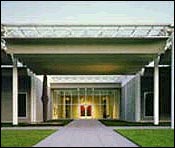
#15 (of 25) NEXT >>
As unlikely as it may seem for a city that calls to mind barbecue, rodeos, and unchecked suburban sprawl, a trip to Houston is a design-geek hajj. For starters, there are the glassy downtown skyscrapers by Johnson, Pei, and Pelli. Then there’s the angular and dramatic Museum of Fine Arts—one building by Mies van der Rohe, another by Moneo, the two connected by a tunnel of light designed by James Turrell. But most important, there’s the legacy of Dominique de Menil—oil heiress, patroness of the arts, 50-year resident, and doyenne of dazzlingly eclectic taste.
In 1980, De Menil gave the architect Renzo Piano his first American commission: a home for her vast art collection. To this day, Piano calls the Menil his most modern building—more innovative, even, than Beaubourg—with its careful roof of glass, steel, and concrete louvers designed to filter the Texas sun and bathe the holdings (everything from African and Oceanic tribal art to one of the world’s most extensive collection of Magrittes to those exquisite Joseph Cornell boxes) in a milky glow.
The museum is the anchor of a 26-acre park incorporating several world-class architectural sites: Behind the central building and across a quiet street is more Piano—an annex devoted exclusively to the work of Cy Twombly, added in 1995. An hour in this soaring, naturally lit space built to accommodate canvases of staggering proportions is as curative as a week at Canyon Ranch. Across a sculpture garden (Barnett Newman, Tony Smith) is the octagonal Rothko Chapel, designed by Howard Barnstone from a Philip Johnson plan, with its fourteen dark, moody Rothko canvases. Here, design junkies regularly stretch out on yoga mats for hours at a time to soak up the aesthetic divinity. Most recently, François de Menil (Dominique’s son and a New York–based architect) contributed the Byzantine Fresco Chapel to the complex—a stark, modern shape that houses the only thirteenth-century Byzantine frescoes in the Western Hemisphere.
It only follows that the De Menil family home, just a short drive away, is a design landmark, too. Built by Johnson in 1949, the house is low-slung brick and glass with a flat roof, one of the first examples of International Style built in the U.S. It’s even more intriguing for its luscious interiors by couturier Charles James. After so much Modernism, Dominique said at the time, she needed “something more voluptuous.”
DETAILS
The Museum of Fine Arts (713-639-7300). The Menil Collection complex (713-525-9400; menil.org). Cafe Annie (713-840-1111) offers an elegant take on southwestern grub. At the lushly renovated Hotel Icon (713-224-ICON; hotelicon.com; from $169) in downtown Houston, Jean-Georges runs the restaurant (and the room service).